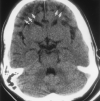CT findings in the infantile form of citrullinemia
- PMID: 11847065
- PMCID: PMC7975255
CT findings in the infantile form of citrullinemia
Abstract
Citrullinemia is a rare autosomal recessive inborn error of the urea cycle due to a deficiency in argininosuccinic acid synthetase. We present two cases of the infantile form of citrullinemia in which CT revealed bilateral and symmetric corticosubcortical hypoattenuating areas, ulegyric changes, and atrophy in the frontal lobes, as well as atrophy in the gyrus cinguli, insulae, and temporal lobes.
Figures


Similar articles
-
Neonatal citrullinemia: comparison of conventional MR, diffusion-weighted, and diffusion tensor findings.AJNR Am J Neuroradiol. 2004 Jan;25(1):32-5. AJNR Am J Neuroradiol. 2004. PMID: 14729525 Free PMC article.
-
[Citrullinemia type I with recurrent liver failure in a child].Arch Argent Pediatr. 2017 Feb 1;115(1):e39-e42. doi: 10.5546/aap.2017.e39. Arch Argent Pediatr. 2017. PMID: 28097854 Spanish.
-
Teaching NeuroImages: Reversible brain MRI lesions in adult-onset type II citrullinemia.Neurology. 2017 Aug 29;89(9):e115. doi: 10.1212/WNL.0000000000004298. Neurology. 2017. PMID: 28847840 No abstract available.
-
[Disorders of the urea cycle].Ryoikibetsu Shokogun Shirizu. 2000;(29 Pt 4):390-2. Ryoikibetsu Shokogun Shirizu. 2000. PMID: 11031978 Review. Japanese. No abstract available.
-
Prenatal diagnosis of the urea cycle diseases: a survey of the European cases.Am J Med Genet. 1995 Jan 16;55(2):247-50. doi: 10.1002/ajmg.1320550220. Am J Med Genet. 1995. PMID: 7717428 Review.
Cited by
-
A neonatal case of citrullinemia with urolithiasis.Ann Saudi Med. 2004 Sep-Oct;24(5):399-400. doi: 10.5144/0256-4947.2004.399. Ann Saudi Med. 2004. PMID: 15573861 Free PMC article. No abstract available.
-
Neonatal citrullinemia: comparison of conventional MR, diffusion-weighted, and diffusion tensor findings.AJNR Am J Neuroradiol. 2004 Jan;25(1):32-5. AJNR Am J Neuroradiol. 2004. PMID: 14729525 Free PMC article.
-
Inborn errors of metabolism for the diagnostic radiologist.Pediatr Radiol. 2009 Mar;39(3):211-20. doi: 10.1007/s00247-008-1072-x. Epub 2008 Dec 13. Pediatr Radiol. 2009. PMID: 19082997 Review.
References
-
- Mc Murray WC, Mohyuddin F, Rossiter RM. Citrullinuria, a new aminoaciduria associated with mental retardation. Lancet 1962;1:138
-
- Rezvani I. Urea cycle and hyperammonemia. In: Behrman RE, Kliegman RM, Arvin AM, Nelson WE, eds. Nelson Textbook of Pediatrics 15th ed. Philadelphia, Pa: WB Saunders;1996;353– 354
-
- Walser M. Urea cycle disorders and other hereditary hyperammonemic syndromes. In: Stanbury JB, Whyngaarden JB, Frederickson DS, Goldstein SL, Brown MS, eds. The metabolic basis of inherited disease 5th ed. New York, NY: McGraw-Hill;1985;419– 420
-
- Saheki T, Kobayashi K, Inoue I. Hereditary disorders of the urea cycle in man: biochemical and molecular approaches. Rev Physiol Biochem Pharmacol 1987;108:21– 68 - PubMed
-
- Wayenberg JL, Vermeylen D, Gerlo E, Pardou A. Increased intracranial pressure in a neonate with citrullinaemia. Eur J Pediatr 1992;151:132– 133 - PubMed
Publication types
MeSH terms
LinkOut - more resources
Full Text Sources
Medical
